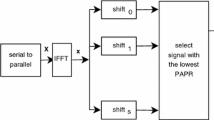Abstract
Because of its lack of feedback process and the simplicity of its searching algorithm, conventional selected mapping (CSLM) is an efficient peak-to-average power ratio (PAPR) reduction technique in orthogonal frequency division multiplexing systems compared to the present techniques such as partial transmit sequence and active constellation extension. The requirement for large numbers of inverse fast Fourier transform (IFFT) blocks to provide desired PAPR reduction performance is introduced as the most significant drawback of the CSLM. This paper uses the special structure of an N-point radix-II IFFT in the CSLM and proposes a low complexity method to reduce the redundant calculations with almost the same PAPR reduction, bit-error rate, and power spectral density performances as those of the CSLM. The simulation results show that the computational complexity is reduced by at least 46.8% compared to that of the CSLM with approximately the same PAPR performance.









Similar content being viewed by others
References
Rodrigues, M. R. D., & Wassell, I. J. (2006). IMD reduction with SLM and PTS to improve the error-probability performance of nonlinearly distorted OFDM signals. IEEE Transactions on Vehicular Technology, 55(2), 537–548.
Baxley, R. J., & Zhou, G. T. (2007). Comparing selected mapping and partial transmit sequence for PAR reduction. IEEE Transaction on Broadcasting, 53(4), 797–803.
Varahram, P., & Ali, B. M. (2011). Partial transmit sequence scheme with new phase sequence for PAPR reduction in OFDM systems. IEEE Transactions on Consumer Electronics, 57(2), 366–371.
Ahmed, S., & Kawai, M. (2013). Interleaving effects on BER fairness and PAPR in OFDMA system. Telecommunication Systems,. doi:10.1007/s11235-011-9557-6.
Li, C. P., Wang, S. H., & Wang, C. L. (2010). Novel low-complexity SLM schemes for PAPR reduction in OFDM systems. IEEE Transactions on Signal Processing, 58(5), 2916–2921.
Varahram, P., & Ali, B. M. (2014). A crest factor reduction scheme based on recursive optimum frequency domain matrix. IEEE Transactions on Consumer Electronics, 60(2), 179–183.
Kim, K. H., Jeon, H. B., No, J. S., & Shin, D. J. (2013). Low complexity selected mapping scheme using cyclic-shifted inverse fast Fourier transform for peak-to-average power ratio reduction in orthogonal frequency division multiplexing systems. IET Communications, 7(8), 774–782.
Kazemian, M., Varahram, P., Ali, B. M., & Mohammady, S. (2015). A low complexity PAPR reduction scheme based on Radix-II IFFT. IEEE international conference on consumer electronics, pp. 420–421.
Varahram, P., & Ali, B. M. (2011). A low complexity partial transmit sequence for peak to average power ratio reduction in OFDM systems. Radio Engineering, 20(3), 677–682.
Varahram, P., & Ali, B. M. (2013). Low complexity partial transmit sequence with complex Gain memory predistortion in OFDM systems. Wireless Personal Communications, 68(3), 1435–1448.
Kazemian, M., Varahram, P., Hashim, S. J., Ali, B. M., Mohammady, S., & Sulaiman, N. (2014). Peak-to-average power ratio reduction based on cross-correlation in OFDM systems. International conference on advanced communications technology, pp. 244–248.
Acknowledgements
This work was supported by Universiti Putra Malaysia under the Prototype Development Research Grant Scheme (PRGS) No. 5528700.
Author information
Authors and Affiliations
Corresponding author
Appendix
Appendix
In this appendix, the proposed scheme and some equations are described for an N-point radix-2 IFFT where \(N=8\) and \(K=4\). As mentioned above, K is a variable that is specified by the user and determines the computational complexity and PAPR reduction value. If \(m^{{\prime }}=0,1\), then:
Therefore, the input signal is partitioned into the 4 groups by the proposed approach. The required matrices are defined as
The matrix \(Y_1 \) shows that by changing the phase sequences 4 times, only 2 input samples are changed, and the other samples are fixed. Hence,\(R_l \), \(R_{l+N/8} \), \(G_d \), and \(H_d \) have to be calculated once, saved, and used for the subsequent rows, whereas in the CSLM method, all similar calculations should be performed during each searching procedure. According to Table 1, for \(q=3\) and \(l=0\), the saved parameters are \(G_0 ,\;G_1 ,\;G_2 ,\;G_3 ,\;R_0 \), and \(R_1 \) where \(R_0 =\alpha _0 +W^{0}\beta _0 \) and \(R_1 =\alpha _0 -W^{0}\beta _0 \) \((\alpha _0 =X_5 , \beta _0 =X_1 )\). \(T_{K,_{\Pr o-Mul} } \) has 2 parts. The first part is related to the calculations of the first row, and the second part is for the other rows of the selected matrix. \(T_{K,_{\Pr o-Mul} } \) and \(T_{K,_{CSLM-Mul} }\) with \(K=4\) and \(N=8\), are evaluated as
Referring to (40) the second part is shown by bold circles in Fig. 4 (i.e., 7 multipliers for each row, except the first row). The following matrix is generated, whit \(N=8\) and \(K=8\):
Rights and permissions
About this article
Cite this article
Kazemian, M., Varahram, P., Hashim, S.J. et al. A low complexity peak-to-average power ratio reduction scheme based on selected mapping and radix-II IFFT in OFDM systems. Telecommun Syst 67, 21–30 (2018). https://doi.org/10.1007/s11235-017-0312-5
Published:
Issue Date:
DOI: https://doi.org/10.1007/s11235-017-0312-5




